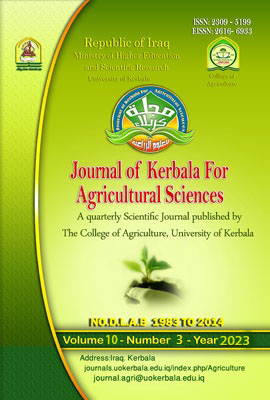Diversity and molecular identification of endosymbionts of the white-flies Bemisia tabaci and Trialeurodes vaporariorum
DOI:
https://doi.org/10.59658/jkas.v10i3.1235Keywords:
Bemisia tabaci, Trialeurodes vaporariorum, endosymbiont bacte-ria, 16S rRNA and 23S rRNAAbstract
The infection of insects with symbiotic bacteria has significant implications for the evolution and ecology of the hosts. Maternally inherited symbionts associated with B. tabaci and T. vaporariorum whiteflies play a vital role in their fitness and survival. Whitefly symbionts have been identified in many countries, but no study has been undertaken in Iraq and the UK. For the first time in both countries, the molecular identification and diversity of the symbionts of both whiteflies have been investigated in the present study. Fourteen populations of B. tabaci from Iraq and twenty populations of T. vaporariorum from the UK were used to detect and identify seven common endosymbiont bacteria associated with whitefly using the 16S rRNA and 23S rRNA nuclear markers. All females and males of B. tabaci harboured one primary symbiont, Portiera aleyrodidarum, and almost all of both sexes of all B. tabaci species have the two secondary symbionts Hamiltonella sp. and Rickettsia sp. The primary symbiont P. aleyrodidarum was also detected in both sexes of T. vaporariorum, whereas only one secondary symbiont, Arsenophonus sp., was detected in almost all females but not in the males. Additionally, an investigation into genetic diversity using three genes of the Arsenophonus sp. populations showed no variation among different populations. The results supported the notion that Arsenophonus sp. might play an important role in the survival of T. vaporariorum females and maybe a killer of male whiteflies. Also, secondary symbionts Hamiltonella sp. and Rickettsia sp. with B. tabaci could support their host’s fitness and survival. These findings reveal the endosymbionts associated with B. tabaci and T. vaporariorum in Iraq and the UK, respectively. Further investigation is needed to understand the roles of these symbionts in both countries
Downloads
Published
How to Cite
Issue
Section
License
Copyright (c) 2023 Copyright (c) 2024 is the Author's article. Published by the Journal of Kerbala for Agricultural Sciences under a CC BY 4.0 license

This work is licensed under a Creative Commons Attribution 4.0 International License.
Licensing Terms
All articles are published under a Creative Commons License and will be directed to the Creative Commons Attribution 4.0 International License (CC BY 4.0) That permits use, distribution, and reproduction in any medium, provided the original work is properly cited. This license also allows the work to be used for commercial purposes.
Use by both non-commercial and commercial users
This content is licensed under a Creative Commons Attribution 4.0 International (CC BY 4.0) license, permitting use by both non-commercial and commercial users. Individual users may access, download, copy, display, and redistribute the articles to colleagues, as well as adapt, translate, and text- and data-mine the content, subject to the following conditions:
- The author's moral rights, including the right of attribution and the right to protect their work from derogatory treatment, are respected.
- Where content in the article is identified as belonging to a third party, users must ensure that any reuse complies with the copyright policies of the owner of that content.
- If the article content is reused for research or educational purposes, users should maintain a link to the appropriate bibliographic citation, including the DOI and a link to the published version on the journal's website.






